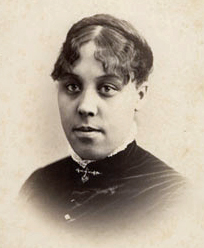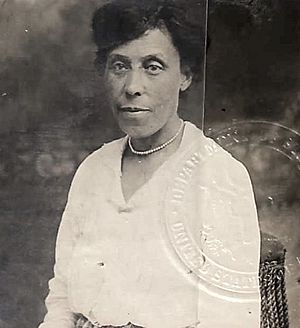Ida Gibbs facts for kids
Quick facts for kids
Ida Alexander Gibbs Hunt
|
|
|---|---|
 |
|
| Born |
Ida Alexander Gibbs
November 16, 1862 Victoria, British Columbia, Canada
|
| Died | December 19, 1957 (aged 95) Washington, D.C.
|
| Resting place | Lincoln Memorial Cemetery |
| Alma mater | Oberlin College |
| Occupation | Educator, Civil Rights Activist, & Pan-Africanist |
| Spouse(s) |
William Henry Hunt
(m. 1904) |
| Relatives | Father, Mifflin Wistar Gibbs; Sister, Harriet Gibbs Marshall |
Ida Alexander Gibbs Hunt (born November 16, 1862 – died December 19, 1957) was an important person who worked for fairness for all people. She believed everyone should be treated equally, no matter their race or gender. In 1905, she helped start one of the first YWCAs in Washington, D.C. for African-American women.
Ida was the daughter of Judge Mifflin Wistar Gibbs, who was a very successful Black man. She was also married to William Henry Hunt, who was a diplomat. Ida was a close friend of W. E. B. Du Bois, and together they were leaders in the early Pan-African movement. This movement aimed to unite and empower people of African descent around the world.
Contents
Early Life and School
Ida's father, Judge Mifflin Wistar Gibbs, was one of the richest African-Americans in the United States in the late 1800s. Before he became wealthy, he and his wife, Maria Ann Alexander Gibbs, traveled a lot. They went from Pennsylvania to California, and then to Vancouver Island in Canada. Ida Alexander Gibbs Hunt was born there on November 16, 1862, in Victoria, British Columbia.
In 1872, when Ida was ten, her family moved back to the United States. By then, they were a very well-off family. Ida was the third of five children and the oldest daughter. Her sister, Harriet Gibbs Marshall, also became a notable person.
Ida went to Oberlin College, which was a special school because it was the first college to treat African-American men and all women equally. She studied many subjects there, including philosophy and arts. In 1884, she was among the first group of Black women to graduate from Oberlin, alongside Mary Church Terrell and Anna Julia Cooper. These women were among the very first African-American women to earn a university degree. Ida was also chosen to be the president of the Oberlin Literary Society. In 1892, she earned her master's degree.
Career and Activism
Teaching Career
Before she got married, Ida Gibbs worked as a teacher. She taught Latin and mathematics. However, she had to stop teaching when she married. This was because, until 1920, married women working in public schools in Washington, D.C., were not allowed to keep their jobs.
Ida taught English at Alabama Agricultural and Mechanical College. She also taught at Florida A&M University in Tallahassee. Later, she taught in Washington, D.C., at Armstrong Manual Training High School and M Street High School. M Street High School was a very respected school for African-American students preparing for college. In the 1920s, this school, later called Dunbar High School, was famous because four of its Black women teachers, including Ida Gibbs, had advanced degrees.
On April 12, 1904, Ida married William Henry Hunt. After her marriage, she left her teaching career. She traveled with her husband as he took on diplomatic jobs in other countries.
Life as a Diplomat's Wife
After marrying, Ida Gibbs Hunt joined her husband on his diplomatic assignments. They lived in places like Liberia, France, Madagascar, and Guadeloupe. Traveling with her husband helped Ida see how racial unfairness affected people worldwide. She noticed that the fight for Black rights in the United States was similar to the struggles of African people living under colonial rule in other parts of the world.
YWCA and Red Cross Work
Ida Gibbs Hunt worked hard for civil rights in many ways. She supported education for Black people, fought for civil rights, and advocated for women's right to vote. Between 1905 and 1907, Gibbs Hunt returned to the United States. She supported the new Young Women's Christian Association (YWCA) in Washington D.C. She helped create the first YWCA for Black women and became a board member of the Phyllis Wheatley YWCA.
In 1906, she attended a conference for the National Association of Colored Women (NACW). There, she spoke about how African women resisted Belgian colonists in the Congo. During World War I, Gibbs Hunt helped the French Red Cross. She assisted Belgian refugees and visited injured Allied soldiers.
After World War I, Ida began writing for The Crisis magazine. She used the pen name Iola Gibson.
Pan-African Movement
The Paris Peace Conference in 1919 was a turning point for Ida Gibbs Hunt. It marked the start of her bigger role in politics. She helped W.E.B. DuBois organize several Pan-African Congresses. These meetings brought together people of African descent to discuss their rights and future.
Ida encouraged Du Bois to come to France, where she was living. She wanted him to speak up for global racial equality during the peace talks after the war. It's likely that Gibbs Hunt introduced Du Bois to Blaise Diagne, a Black French politician. Diagne then helped get the French government's approval for the 1919 Pan-African Congress. Du Bois relied on Gibbs Hunt because she spoke French fluently, was good at organizing, and had important political connections. She was the main translator at the 1919 Paris Pan-African Congress. Her main goal was to unite Africans around the world for a common cause.
She also spoke about world disarmament and asked for Black representatives at the 1923 London Third Pan-African Congress. She wrote a paper called “The Colored Races and the League of Nations.” She and W.E.B. DuBois were co-chairs of the Conference's Executive Committee.
Civil and Women's Rights
In the United States, Ida Gibbs Hunt was involved in the Niagara Movement and the NAACP. She also joined other groups like the Club Franco-Étranger, the Book Lover’s Club, the Bethel Literary Society, the Washington Welfare Association, and the Women’s International League for Peace and Freedom. Ida Gibbs Hunt, along with other Black women who shared her views, fought for racial and gender equality. They wanted to create a global group of women working together for these rights.
Gibbs Hunt wrote articles for important history journals like the Journal of Negro History and the Negro History Bulletin. Some of her articles included “The Price of Peace” (1938), “Civilization and the Darker Races” (no date), and “Recollection of Frederick Douglas” (1953). Through her writing, she shared her ideas about how to make progress for racial equality. These ideas came from her experiences living on three different continents.
Death and Legacy
Ida Gibbs Hunt passed away in Washington, D.C., on December 19, 1957.
While Du Bois is often seen as the main leader of the Pan-African movement, Ida Gibbs Hunt was a key organizer behind the 1919 conference. She also remained an important member of the Executive Committee in the years that followed. Her work was crucial in bringing people together and fighting for justice worldwide.


